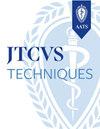Novel, noninvasive, extended reality–aided pulmonary tumor marking method for sublobar resection in minimally invasive surgery
IF 1.9
Q3 CARDIAC & CARDIOVASCULAR SYSTEMS
引用次数: 0
Abstract
Objective
We developed a novel, noninvasive, extended reality–aided marking procedure for tumor localization and aimed to evaluate its feasibility and safety for sublobar resection in minimally invasive surgery.
Methods
We prospectively evaluated the concordance rate between extended reality–aided marking and actual tumor localization for 20 patients who underwent sublobar resection, including wedge resection and segmentectomy. During sublobar resection, the augmented reality image of the 3-dimensional pulmonary anatomy and the tumor were overlaid onto the thoracoscopic monitor. This allowed the surgeons to observe the tumor location with the head-mounted mixed reality display during the surgery. Marking concordance was defined as the difference of 10 mm or less between the distances from the actual tumor margin and the identified marking point on the extended reality to the margin.
Results
We enrolled 11 patients who underwent wedge resection and 9 patients who underwent segmentectomy. For each case, the pulmonary anatomy and tumor were successfully overlaid onto the operative image. The median computed tomography tumor size was 13.5 mm (interquartile range, 10.7-21.7 mm). The extended reality–aided marking method accurately delineated 90% of cases (18 of 20). The median distance from the actual surgical margin was 18 mm (interquartile range, 11-23.5 mm). The median duration of surgery was 117 (interquartile range, 64-147) minutes, and the perioperative courses were uneventful for all cases except for paroxysmal atrial fibrillation in 1 patient.
Conclusions
Our novel, noninvasive, extended reality–based marking method is safe and feasible for identifying tumor locations during sublobar resection.
一种新颖的、无创的、扩展的现实辅助肺肿瘤标记方法,用于微创手术中肺叶下切除术
目的开发一种新的、无创的、扩展的现实辅助肿瘤定位标记方法,旨在评估其在微创手术中用于叶下切除的可行性和安全性。方法前瞻性评估20例行叶下切除术(包括楔形切除术和节段切除术)的患者的扩展现实辅助标记与实际肿瘤定位的符合率。在肺叶下切除时,增强现实三维肺解剖图像和肿瘤被覆盖到胸腔镜监视器上。这使得外科医生可以在手术过程中通过头戴式混合现实显示器观察肿瘤的位置。标记一致性定义为实际肿瘤边缘与扩展现实上识别的标记点到边缘的距离相差不超过10mm。结果11例患者行楔形切除术,9例患者行节段切除术。对于每个病例,肺解剖和肿瘤都成功地覆盖到手术图像上。计算机断层扫描肿瘤大小中位数为13.5 mm(四分位数间距为10.7-21.7 mm)。扩展的现实辅助标记方法准确地描绘了90%的病例(18 / 20)。离实际手术切缘的中位数距离为18 mm(四分位数间距为11-23.5 mm)。手术时间中位数为117分钟(四分位数范围64-147),除1例阵发性心房颤动外,所有患者围手术期均平稳。结论采用一种新颖的、无创的、扩展的基于现实的标记方法在叶下切除术中识别肿瘤位置是安全可行的。
本文章由计算机程序翻译,如有差异,请以英文原文为准。
求助全文
约1分钟内获得全文
求助全文

 求助内容:
求助内容: 应助结果提醒方式:
应助结果提醒方式:


